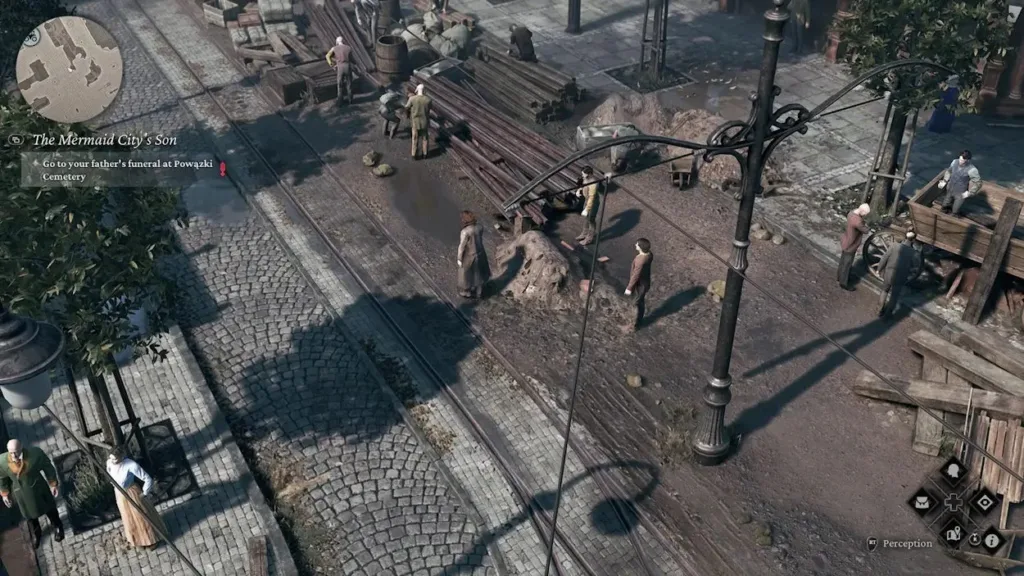
Since the outset, I’ve been drawn to single-player games, particularly RPGs, finding immense enjoyment in their immersive narratives. So, when I stumbled upon The Thaumaturge, a narrative-rich RPG set in a grim universe with a morally ambiguous protagonist, I knew it was tailor-made for me. The combination of its dark setting and complex character immediately captured my interest, promising an unforgettable gaming experience.
Thanks to a copy graciously provided by Fool’s Theory, I’ve been delving into the streets of pre-WW2 Warsaw for over a fortnight now. As the publisher’s second original game, The Thaumaturge is an earnest endeavor in storytelling. It’s a mix of compelling narrative and occasional frustrations, offering plenty of material for discussion. Join me as I delve into the depths of The Thaumaturge in my review below.
Wiktor and His Dilemma
Set against the backdrop of the Russian occupation of Warsaw in 1905, The Thaumaturge casts you as Wiktor Szulski, a practitioner of the arcane arts. Thaumaturges, revered for their mysterious abilities to wield sorcery, manipulate emotions, and perceive hidden truths, navigate a world fraught with tension between Poles and Russians.
Wiktor’s journey is more than just that of a mere magician; he hails from the esteemed Szulski lineage but has spent the last 15 years honing his Thaumaturgical skills abroad. Returning to his homeland, Wiktor finds himself embroiled in trouble, confronting familial discord and personal turmoil.
Despite being a predetermined character with a fully voiced persona, The Thaumaturge’s RPG elements immerse you deeply into Wiktor’s perspective. Rather than feeling constrained, this narrative approach fosters a profound connection with Wiktor’s inner struggles, particularly his strained relationship with his father.

The core narrative of The Thaumaturge revolves around fictional family intrigues and deceit, cleverly intertwined with a backdrop of real-world events and settings. It’s a storytelling technique that I find immensely captivating—using historical context to ground the plot in believability. Fool’s Theory masterfully employs this approach, seamlessly blending fictional elements with the real-world timeline and setting of Warsaw.
The game delves into the depths of historical accuracy, incorporating genuine political issues and figures from Warsaw’s past, such as Rasputin, into its intricate storyline. This inclusion not only adds depth to the game’s lore but also provides players with a richer understanding of the era. Additionally, the tasteful integration of literary references further expands the game’s universe, drawing players deeper into its immersive world.

However, akin to the complexities within Wiktor’s family dynamics, The Thaumaturge encounters its own narrative hurdles. The game occasionally grapples with inconsistent pacing, with certain moments feeling prolonged or losing momentum just as the plot gains traction. While this slower, more deliberate pacing may appeal to aficionados of the slow-burn narrative style, it presented a minor issue for me.
Nevertheless, despite these pacing concerns, the amalgamation of the chosen setting, premise, and overarching plot crafted a captivating universe within The Thaumaturge that I found thoroughly engrossing.
The Characters Fulfill Their Roles Adequately
Regardless of how visually stunning an RPG’s setting may be, the presence of well-crafted characters is essential for a truly immersive experience. In this aspect, The Thaumaturge largely succeeds, albeit with some notable exceptions.
Voice acting plays a significant role in bringing the game’s characters to life, with most of them receiving adequate treatment. However, there are noticeable disparities in performance quality. While protagonists like Wiktor and his supporting cast deliver stellar voice acting, interactions with certain NPCs reveal inconsistencies. For instance, an encounter with an army general early in the game felt stilted and lacking in authenticity, as if the character were merely reciting lines from a script.
Such instances of uneven voice acting detract from the overall immersion, creating a somewhat disjointed experience for players. While there are moments of brilliance scattered throughout the game, these inconsistencies may leave players questioning the efficacy of Fool’s Theory’s screenplay. Despite the commendable efforts of the majority of characters, a more nuanced approach to voice performances could have greatly enhanced the overall immersion and cohesion of The Thaumaturge.
Harness the Power of Salutors for Your Advantage
Despite my previous criticism regarding the voice acting, let me now pivot to discuss the gameplay in The Thaumaturge, which offered a highly satisfying experience. The game adopts an isometric camera view, eschewing the typical first and third-person perspectives. This design choice may polarize gamers, depending on individual preferences. Personally, I found myself in the camp of enthusiasts rather than detractors. Throughout my gameplay journey, I never found the camera angle to be off-putting; instead, I thoroughly enjoyed its implementation.

In addition to the camera perspective, The Thaumaturge boasts various gameplay systems aimed at honing Wiktor’s skills as a Thaumaturge. These include exploring maps for lore pieces, solving puzzles, and advancing through the main story, all of which reward players with XP to level up Wiktor’s Thaumaturgic abilities.
The Thaumaturgy upgrade system comprises two main sections. The first is the upgrade tree, which is further divided into four sub-sections. Investing points in a specific section enhances proficiency in that discipline. For instance, players who focus on upgrading the heart tree will find themselves better equipped to navigate situations requiring empathy and emotional manipulation.

The second aspect of the Thaumaturgy system involves upgrades that enhance available attacks, akin to modifiers. Players can mix and match these upgrades to create a customized set of abilities tailored to their preferences.
While the RPG elements in The Thaumaturge may not reach the depth of titles like The Witcher 3, they still offer a substantial gameplay experience. When viewed in isolation, The Thaumaturge presents an intricate system where players can meticulously craft their version of Wiktor, complete with unique strengths, weaknesses, and quirks, allowing them to navigate the game with ease and personal flair.
Enhanced Combat Dynamics with Intuitive Turn-Based Mechanics
As previously mentioned, Wiktor possesses the unique ability to perceive supernatural entities known as Salutors, which are inaccessible to others. These Salutors can be tamed and befriended by the player, with each one offering distinct powers and abilities. Players have access to a total of eight Salutors, each of which can be utilized for specific tasks, including combat engagements.

Combat in The Thaumaturge adopts a turn-based system from a third-person perspective, with its own unique twist. A crucial element is the duration bar, prominently displayed at the top-middle of the screen. This bar indicates when enemies will execute their attacks, allowing players to strategize accordingly. Timing plays a pivotal role; launching a light attack before the enemy initiates theirs can grant the player an advantage, enabling them to strike first.
Moreover, Wiktor can leverage the abilities of his Salutors to further manipulate the flow of combat, delaying enemy attacks and creating openings for decisive strikes. This innovative approach to turn-based combat adds depth and excitement, providing seasoned RPG enthusiasts with a refreshing challenge to sink their teeth into.

As a gamer, I’ve often had mixed feelings about turn-based combat systems. However, The Thaumaturge’s take on this mechanic proved to be refreshingly engaging. Engaging in battles with the Salutor Upyr offered a thrilling loop where both my character and the Salutor could team up to effectively lock down enemy turns. Experimenting with modifiers unlocked through Thaumaturgy upgrades added an extra layer of enjoyment to the experience.
Graphics and Performance
Overall, The Thaumaturge offers a gameplay experience that is highly adaptable and customizable to suit individual preferences. From the versatile and enjoyable skill trees to the dynamic turn-based combat system and the inclusion of Salutors with their unique dark powers, the game ensures that each player’s experience is uniquely tailored, providing hours of enjoyable gameplay.

The Thaumaturge is set to launch exclusively on Windows PCs. Fortunately, I had my reliable gaming rig at the ready, serving as the ideal platform for this gaming experience. Here’s how the game performed on my setup:
The game exhibited symmetrical utilization of both CPU and GPU, consistently hovering around 62-65%. This remained stable with only a minor variance of 1-2%. However, upon launching the game, the GPU temperature surged to 62 degrees Celsius, indicating a notable increase from its idle temperature of 52 degrees Celsius.
We conducted tests playing The Thaumaturge both with and without upscaling and frame generation features. Without DLSS and frame generation, the frame rate ranged between 84-92FPS. However, with frame generation enabled, this number surged to 130+FPS.
Players equipped with RTX cards or their AMD/Intel counterparts can effortlessly enjoy the game. Utilizing technologies like FSR and XeSS ensures that even non-NVIDIA card users can benefit from upscaling technology. Overall, my experience with the game was exceptionally satisfying.
Verdict: Is the Journey into Dark Poland Worthwhile?
11-Bit Studios has a knack for uncovering hidden gems and elevating them to prominence, as evidenced by their previous published titles like Frostpunk, The Invincible, and This War of Mine. With The Thaumaturge, they once again deliver an exceptional experience.
Whether it’s the immersive yet dark setting, the compelling characters, or the refreshing turn-based combat, the game excels on multiple fronts. While it does grapple with pacing issues and inconsistent delivery, these flaws don’t detract significantly from the overall experience.
Moreover, the abundance of lore pickups and the satisfying gameplay system contribute to the game’s allure, leaving a lasting impression. The Thaumaturge is poised to find a niche among RPG enthusiasts seeking a fresh perspective in a saturated market. Even those who typically shy away from turn-based combat should consider giving it a chance.
In conclusion, based on my experience, I wholeheartedly recommend The Thaumaturge as your next adventure.

Fool’s Theory’s The Thaumaturge seamlessly weaves a captivating fantasy narrative into real-world historical events, introducing us to a diverse cast of eccentric yet engaging characters. Despite occasional pacing issues in the story, the game compensates with its enjoyable gameplay and straightforward RPG mechanics.
Overall, the studio’s endeavor to craft a compelling RPG experience proves largely successful. With its blend of immersive storytelling and accessible gameplay, The Thaumaturge has the potential to appeal to a wide audience, offering an enjoyable journey for anyone willing to give it a try.



